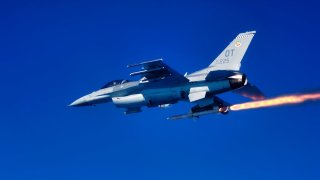Go Inside an F-16 Fighting Falcon Cockpit and Witness Amazingness
The F-16 Fighting Falcon has been considered the best fighter jet on Earth for many reasons, including its overall cost and combat capabilities for that cost.
Meet the F-16 Fighting Falcon - Over the past four decades, the Lockheed Martin F-16 Fighting Falcon has established itself as the most successful western fighter in its class, and even forty years since it entered service, it remains operational with 28 nations around the world.
Production of the aircraft continues, and more than 4,600 have been built to date. With upgrades and enhancements, this warbird will remain operational for decades to come.
F-16: A Short History
The Fighting Falcon was hatched under the United States Air Force's Lightweight Fighter (LWF) program in the 1970s, which had the aim of proving that a fighter could be smaller and cheaper than the F-15, and be just as agile and deadly to America's adversaries. Initially, a General Dynamics project, the company flew its first YF-16 demonstrator in February 1974.
After a competitive fly-off against the Northrop YF-17, the General Dynamics prototype was seen as the superior aircraft and was subject to further development. It grew into the larger and more capable F-16A Fighting Falcon. The United States Air Force initially ordered 650, but that number was later increased to 1,388 – while NATO members including Belgium, Denmark, the Netherlands, and Norway also adopted the F-16. Thus began an export odyssey that continues to this day.
Successive variants have progressively added more weight, avionics, and capabilities, yet all Fighting Falcons retain the salient features of the original production model. That includes control-configured vehicle (CCV) technology, and fly-by-wire flight controls, as well as a generous thrust-to-weight ratio that utilizes a single engine fed by a fixed vertical intake.
The result is a multirole tactical fighter that offers exceptional agility, roll rate, climb, and acceleration.
Notable F-16 Fighting Falcon Features
The F-16A houses a Westinghouse AN/APG-66 coherent pulse-Doppler radar in the radome nose. It operates on the I/J bands, while the antenna is of the planar array (flate plate) type.
Though unusual for a high-performance jet fighter, the F-16 features a simple engine intake with no moving parts. However, the location ensures that the engine is not starved of air even at high angles of attack.
The multi-spar, multi-rib aluminum tailfin features a graphite-epoxy skin and it carries a rudder of aluminum honeycomb structure, powered by a servo-actuator. The fin top also carries a VHF aerial, anti-collision beacon, and directional antennae.
The first sub-variant of the basic F-16A was the combat-capable two-seat F-16B, which was first flown in 1977. The F-16A and F-16B were built in successive blocks, numbered 1, 5, 10, and 15, of which the last introduced a major change in the form of the aircraft's front stabilizer.
The first major advance of the Fighting Falcon came with the single-seat F-16C and two-seat F-16D, which each included an enlarged base leading up to the tailfin and provision for the AIM-120 AMRAAM.
Among the most advanced Fighting Falcons was the Block 60 version, designated the F-16E/F Desert Falcon. Developed for the United Arab Emirates (UAE), it introduced an array of sophisticated avionics, based around the Northrop Grumman AN/APG-80 'agile beam' AESA radar, AN/ASQ-32 Internal FLIR and Targeting System (IFTS) and Falcon Edge internal electronic countermeasure system. The Block 60 first flew in December 2003, and the first Desert Falcons were delivered in May 2005. The aircraft had its combat debut during Operation Unified Protector over the skies of Libya in 2011.
The Fighting Falcon, in its various configurations, will continue to be a deadly hunter in the sky for years to come.
About the Author
Peter Suciu is a Michigan-based writer. He has contributed to more than four dozen magazines, newspapers, and websites with over 3,000 published pieces over a twenty-year career in journalism. He regularly writes about military hardware, firearms history, cybersecurity, and international affairs. Peter is also a Contributing Writer for Forbes. You can follow him on Twitter: @PeterSuciu.


